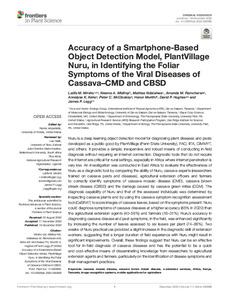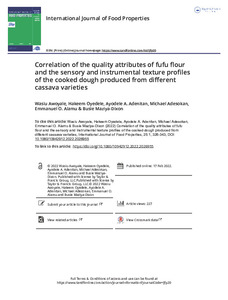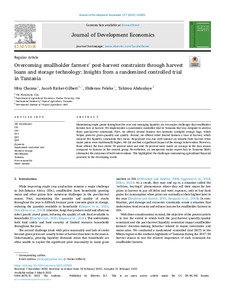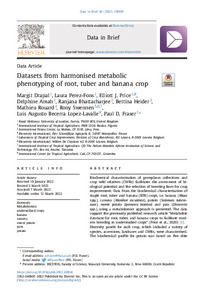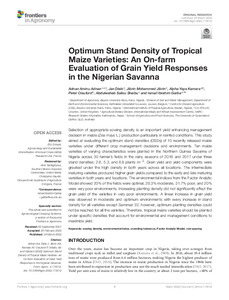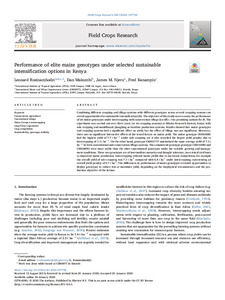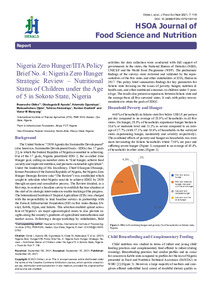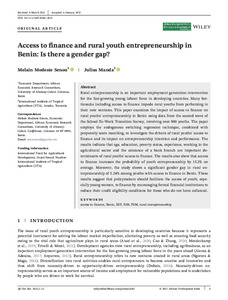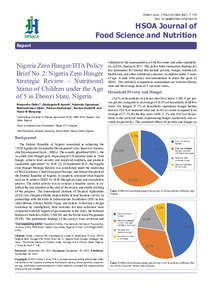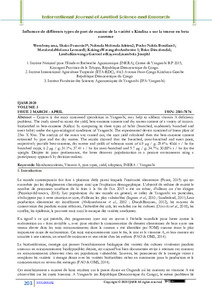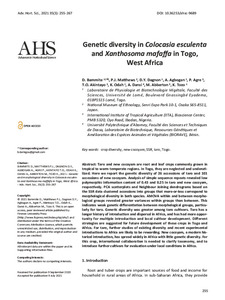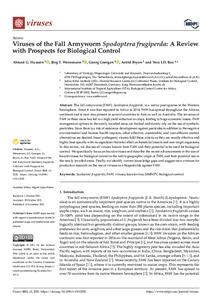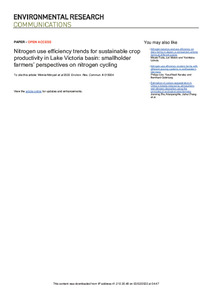Welcome to the International Institute of Tropical Agriculture Research Repository
Journal and Journal Articles: Recent submissions
Now showing items 741-760 of 5157
-
Mediation of potato-potato cyst nematode, G. rostochiensis interaction by specific root exudate compounds
(2020)Potato (Solanum tuberosum) is a widely consumed staple food crop worldwide whose production is threatened by potato cyst nematodes (PCN). To infect a host, PCN eggs first need to be stimulated to hatch by chemical components in the host root exudates, yet it remains unknown how most root exudate components influence PCN behavior. Here, we evaluated the influence of eight compounds identified by LC-QqQ-MS in the root exudate of potato on the hatching response of the PCN, Globodera rostochiensis at ... -
Accuracy of a smartphone-based object detection model, PlantVillage Nuru, in identifying the foliar symptoms of the viral diseases of cassava-CMD and CBSD
(2020)Nuru is a deep learning object detection model for diagnosing plant diseases and pests developed as a public good by PlantVillage (Penn State University), FAO, IITA, CIMMYT, and others. It provides a simple, inexpensive and robust means of conducting in-field diagnosis without requiring an internet connection. Diagnostic tools that do not require the internet are critical for rural settings, especially in Africa where internet penetration is very low. An investigation was conducted in East Africa ... -
Correlation of the quality attributes of fufu flour and the sensory and instrumental texture profiles of the cooked dough produced from different cassava varieties
(2022)There is little or no information on the relationship between the quality of fufu flour and the textural attributes of cooked dough. Quality attributes of flour were therefore correlated with the sensory texture profile analysis (STPA) and instrumental texture profile analysis (ITPA) of the dough produced from six varieties of cassava. Results showed that the water absorption capacity (WAC) of flour had a positive correlation (p < .05, r = 0.90) with the STPA moldability of the cooked dough and a ... -
Overcoming smallholder farmers’ post-harvest constraints through harvest loans and storage technology: insights from a randomized controlled trial in Tanzania
(2022-06)Maintaining staple grains throughout the year and managing liquidity are two major challenges that smallholder farmers face at harvest. We implemented a randomized controlled trial in Tanzania that was designed to address these post-harvest constraints. First, we offered treated farmers two hermetic (airtight) storage bags, which helped preserve grain quantity and quality. Second, we offered other treated farmers a loan at harvest, which reduced the liquidity constraints they faced. Repayment was ... -
Datasets from harmonised metabolic phenotyping of root, tuber and banana crop
(2022-06)Biochemical characterisation of germplasm collections and crop wild relatives (CWRs) facilitates the assessment of biological potential and the selection of breeding lines for crop improvement. Data from the biochemical characterisation of staple root, tuber and banana (RTB) crops, i.e. banana (Musa spp.), cassava (Manihot esculenta), potato (Solanum tuberosum), sweet potato (Ipomoea batatas) and yam (Dioscorea spp.), using a metabolomics approach is presented. The data support the previously ... -
Optimum stand density of tropical maize varieties: an on-farm evaluation of grain yield responses in the Nigerian Savanna
(2022)Selection of appropriate sowing density is an important yield enhancing management decision in maize (Zea mays L.) production particularly in rainfed conditions. This study aimed at evaluating the optimum stand densities (OSDs) of 10 recently released maize varieties under different crop management decisions and environments. Ten maize varieties of varying characteristics were planted in the Northern Guinea Savanna of Nigeria across 30 farmer’s fields in the rainy seasons of 2016 and 2017 under ... -
Performance of elite maize genotypes under selected sustainable intensification options in Kenya
(2020-04-01)Combining different cropping and tillage systems with different genotypes across several cropping seasons can reveal opportunities for sustainable intensification (SI). The objective of this study was to assess the performance of six maize genotypes under intercropping with conservation tillage (no-till) – two promising options for SI. The experiment was carried out over three years (or six cropping seasons) at Kiboko Research Station, Kenya with sole cropping and mouldboard ploughing as baseline ... -
Unravelling causes of poor crop response to applied N and P fertilizers on African soils
(2022)A number of studies across sub-Saharan Africa have recently reported poor crop responses and low agronomic use efficiencies of applied nitrogen (AEN), phosphorus (AEP) and potassium (AEK). However, the conditions under which non-responsiveness occurs, its underlying causes and its probability of occurrence on different soil types are not well understood. Using data from 542 sites and 14 soil types in 23 African countries, we provide novel insights into the linkage between lack of response to applied ... -
Access to finance and rural youth entrepreneurship in Benin: Is there a gender gap?
(2022)Rural entrepreneurship is an important employment generation intervention for the fast-growing young labour force in developing countries. Many bottlenecks including access to finance impede rural youths from performing in their new ventures. This paper examines the impact of access to finance on rural youths' entrepreneurship in Benin using data from the second wave of the School-To-Work Transition Survey, involving over 900 youths. The paper employs the endogenous switching regression technique, ... -
Influence de differents types de port de manioc de la variete << Kindisa >> sur la teneur en beta carotene
(2020-03)Cassava is the most consumed speculation in Yangambi, may help to address vitamin A deficiency problems. The study aimed to assess the yield, beta-carotene content and dry matter content of a variety of cassava. biofortified in beta-carotene (Kidisa) by comparing its three types of habit (branched, moderately branched and erect habit) under the agro-ecological conditions of Yangambi. The experimental device consisted of linear plots of 25m X 50m. The analysis of the mean was carried out, the root ... -
Genetic diversity in Colocasia esculenta and Xanthosoma mafaffa in Togo, West Africa
(2021)Taro and new cocoyam are root and leaf crops commonly grown in tropical to warm temperate regions. In Togo, they are neglected and underutilized. Here we report the genetic diversity of 26 accessions of taro and 101 accessions of new cocoyam. Analysis of simple sequence repeats revealed low polymorphic information content of 0.43 and 0.25 in taro and new cocoyam, respectively. PCA scatterplots and Neighbour Joining dendrograms based on the SSR data clustered accessions into groups that moreorless ... -
Impact of youth-in-agribusiness program on employment creation in Nigeria
(2021)The increasing rate of youth unemployment in Africa, particularly in Nigeria, remains among the challenges to social and economic stability. Accordingly, the Nigerian government implemented several interventions, including the Youth-in-Agribusiness (YIA) program to reduce youth unemployment. However, the effect of these programs on gainful employment creation is yet to be documented. Therefore, this study examined the impact of the YIA program on creating gainful employment among the youth. ... -
Viruses of the fall armyworm Spodoptera frugiperda: a review with prospects for biological control
(2021)The fall armyworm (FAW), Spodoptera frugiperda, is a native pest species in the Western hemisphere. Since it was first reported in Africa in 2016, FAW has spread throughout the African continent and is now also present in several countries in Asia as well as Australia. The invasion of FAW in these areas has led to a high yield reduction in crops, leading to huge economic losses. FAW management options in the newly invaded areas are limited and mainly rely on the use of synthetic pesticides. Since ... -
Temperature influences on interactions among aflatoxigenic species of Aspergillus section flavi during maize colonization.
(2021)Fungal species within Aspergillus section Flavi contaminate food and feed with aflatoxins. These toxic fungal metabolites compromise human and animal health and disrupt trade. Genotypically and phenotypically diverse species co-infect crops, but temporal and spatial variation in frequencies of different lineages suggests that environmental factors such as temperature may influence structure of aflatoxin-producing fungal communities. Furthermore, though most species within Aspergillus section Flavi ... -
Antioxidant and starch-hydrolyzing enzymes inhibitory properties of Striga-resistant yellow-orange maize hybrids
(2021)Most of the health benefits derived from cereals are attributed to their bioactive compounds. This study evaluated the levels of the bioactive compounds, and the antioxidant and starch-hydrolyzing enzymes inhibitory properties of six pipeline Striga-resistant yellow-orange maize hybrids (coded AS1828-1, 4, 6, 8, 9, 11) in vitro. The maize hybrids were grown at the International Institute of Tropical Agriculture (IITA), Nigeria. The bioactive compounds (total phenolics, tannins, flavonoids, and ... -
Nitrogen use efficiency trends for sustainable crop productivity in Lake Victoria basin: smallholder farmers' perspectives on nitrogen cycling
(2022)Nitrogen Use Efficiency (NUE) is one of the established metrics for benchmarking management of Nitrogen (N) in various systems. Numerous approaches to calculate NUE exist, making it difficult to compare the performances of systems depending on the methodology used. This study adopted the conceptualized framework by European Union Nitrogen Expert Panel (EUNEP) to calculate NUE values for cereal crops to determine future trends for the first time in the Lake Victoria region. Data were collected ...


